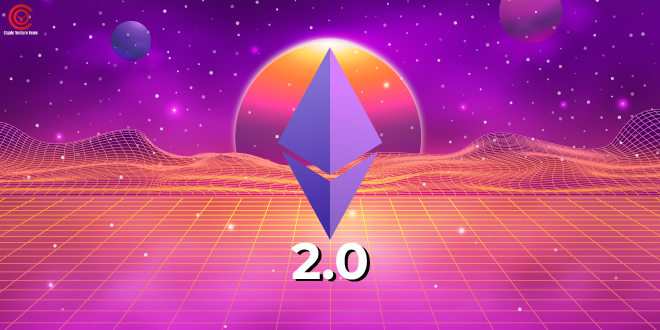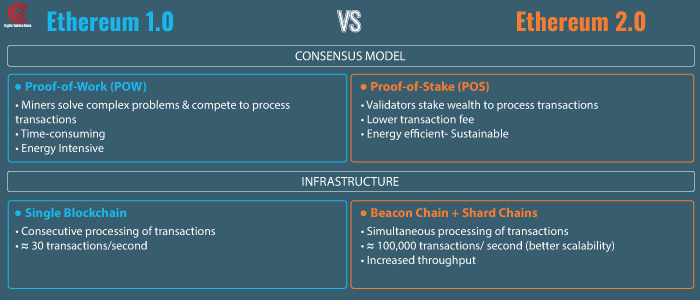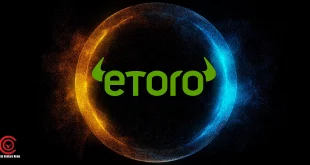Update: The Ethereum Merge was earlier expected to be conducted on 1st of December 2020. Later the ETH merge postponed date was announced to be 6th of September 2022 at 11:34:47 am UTC with the launch of the Bellatrix upgrade for the epoch 144896. However, the final date of Ethereum (ETH) merge was confirmed for 15th of September 2022.
Finally, the merge of Ethereum is completed on the last-mentioned date at around 2:43 am EST. The expectation for the software update, also known as the Mainnet merge was so very high that even it had its own Google widget showing the Ethereum merge countdown timer. Even the Ethereum 2.0 merge date reddit thread had a lot of comments every minute. The Ethereum merge testnet that is the Goerli testnet merge had already been conducted on the 10th of August, 2022.
The Ethereum 2.0 has been working for its launch, and finally, it is on its way. This massive update which is also known as ETH2 or “Serenity” focuses to address the security and scalability of the Ethereum network as it alters from PoW (Proof of Work) to PoS (Proof of Stake).
Ethereum 2.0: PoW vs PoS
Ethereum 2.0 is shifting to Proof of Stake from Proof of Work. How are they both different? In this part let us find out the problems that PoW creates and PoS can solve those. If you have been looking for what Ethereum merge?, then here is the perfect answer for you.
The Issue With PoW (Proof of Work)
In the system of Proof of Work, miners avail high-end computer hardware and processing power to solve complex mathematical problems and verify the latest transactions. The first miner who has successfully solved the problem adds a new block in the blockchain and is then offered with a newly mined crypto. This type of consensus mechanism is seen in digital currencies like BTC (Bitcoin). Even though this system is highly secure, this system often faces issues with accessibility and scalability as in the scenario of BTC mining.
Let us begin with scalability. In Proof of Work, the blockers are mined sequentially, there is a maximum capacity for each block. This implies that it has the ability to only process a limited amount of data in a specified amount of time. Once the capacity is attained, the remaining transactions will have to pause for the upcoming block and so on. This causes lag or delay in the speed of transactions.
On the accessibility, the barriers to entry of a PoW miner can be pretty high. The user will be required to purchase and set up all the important hardware and to get a significant return from the rewards, the user will be required to stay in a region with lower electricity costs to make up for the energy that they will be using.
How Proof Of Stake Will Help?
Instead of using the miners for adding blocks to the chain, transaction validators stake their crypto for the right of verifying a transaction. Miners are being replaced by these validators as individuals who maintain the blockchain platform and verify its transactions. As a result, they will also be the ones to get the rewards for the blocks.
Transaction validators are chosen to propose a block on the amount of crypto they hold and the time period of their holdings. Only these validators can attest that they have witnessed a block. Once the block receives enough attestations only then can they be added to the blockchain?
Ethereum vs Ethereum 2.0
By now, you are probably thinking about how Ethereum 2.0 operates and how it is different from the Ethereum that is presently functional. ETH2 emphasizes bringing changes that will take care of the scalability and throughput network scrutiny through the Bellatrix Upgrade and inclusion of Beacon Chain.
First, let us discuss throughput and scalability. Presently, the Ethereum network can only support nearly 30 transactions every second. It may look like a lot, but with the value of crypto increasing, the network can often become congested. Ethereum 2.0, on the contrary, promises up to 10,000 transactions every second. To attain that goal, it will be making use of something known as shard chains.
Shard chains are a scalability apparatus that will dramatically enhance the throughput of the Ethereum network. It will do this by “splitting” up the blockchain. Presently, the Ethereum blockchain is one chain that is made up of sequential blocks. Even though this makes it highly secure and makes data easier to verify, miners are required to verify transactions consecutively implying that it may impact the ability to carry on transactions fast, especially during the times of high activity.
By dividing the blockchain, the data processing duty is divided between many nodes. This implies that transactions can be treated in parallel rather than successively.
Next, coming to security. Ethereum 2.0 has been designed with security in mind. Many of the PoS networks we see today will usually have a small number of validators which means that the system is more focused (thus, less secure). However, ETH2 will need a minimum of 16,384 validators, implying that it will be more secure and decentralized.
The Ethereum 2.0 Roadmap
The release for Ethereum 2.0 that was launched in December 2020, started with the first of its three phases and since then the Ethereum merge news was everywhere:
- Phase 0: This stage of Ethereum 2.0 saw the implementation of the Beacon Chain, which stores and handles the registry of all validators. Later down the line, it will implement the PoS consensus apparatus but keep Ethereum 1.0’s PoW chain operating to ensure continuity.
- Phase 1: The next phase is likely to roll out this year. This phase will witness the execution of the shard chains that we were talking about before, which will divide the blockchain into 64 varied chains and, in turn, enable the parallel transaction, storing, and processing of data.
- Phase 2: Phase 2, even though not as defined as the other phases, will entail adding Ether accounts that will allow transfers and withdrawals, enforcing cross-shard transfers and contract calls, creating execution environments so that the scalable applications can be created on top of ETH2, and delivering the ETH1 chain into ETH2 so that PoW can finally be turned off. This is planned to take place later this year or in the next year and possibly Ethereum merge date 2022 will be fixed.
Conclusion
While the users wait for the Ethereum 2.0 to roll out as per the Ethereum merge news, the Ethereum 1.0 is completely functional. A time will come when ETH1 will be a part of the ETH2 chain, and even after that, Ethereum will continue to operate just as it does now. The Ethereum 2.0 launch date was on 1 December 2020.
As far as the price is concerned, no one can say how far it will be affected. In theory, higher scalability will imply higher usage, which in turn can imply more demand. And if the user of Ethereum increases, the value can increase. There are some who even predict that the Ethereum price of Ethereum gas may decrease after ETH2 is completely operational. Here is what you need to know about the Ethereum Merge Price Prediction.
- The Bitcoin Wallet Boom: Why Demand Is Skyrocketing - 25/11/2023
- How To Choose The Best Crypto Exchange Affiliate Programs - 03/03/2023
- Crypto License: How To Get It Now? - 03/02/2023
 Crypto Venture News One stop Crypto Track Down
Crypto Venture News One stop Crypto Track Down 








